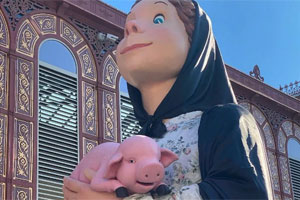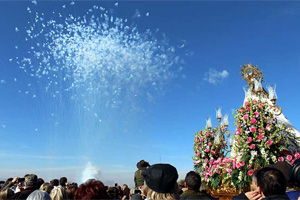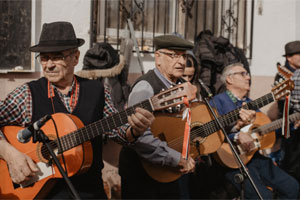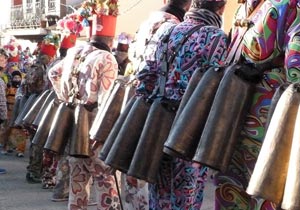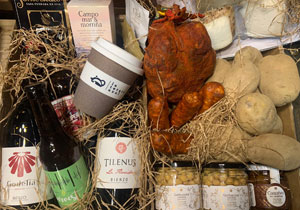San Pascual Bailón and Festival of Zarrón in Almazán
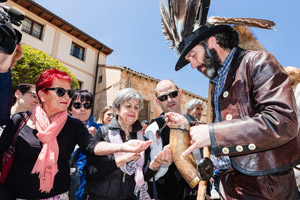
What is the Fiesta del Zarrón?
The Fiesta del Zarrón is a folk tradition in the town of Almazán, Soria, honoring Saint Paschal Baylon, the patron saint of shepherds. Shepherds used to carry a stick with a leather bladder to protect their sheep from wolves, and now participants collect candy during the procession. The Zarrón, dressed in furs, hits those who try to take the candy. The festivity includes 18th-century dances and the presence of two bizarre figures with fox tails.
The Fiesta del Zarrón is a celebration with pastoral symbolism that involves all inhabitants of Almazán. It has its origins in the founding of the Brotherhood of Saint Paschal Baylon in 1816. The festivity consists of a procession of the saint, where the dancers perform the "paloteo" dance, and the Zarrón protects the dance and gives hits.
During the procession, chants are sung like "Tío Zarrón, Tío Maragón, the milk soups are so delicious." Young people try to challenge the Zarróns to get the candy, while there are races to escape them. The Fiesta del Zarrón involves the participation of the dancers, the "palillero," the Zarróns, the mayordomo, and the secretary, each with specific roles.
The mayordomo, chosen among the oldest members of the Brotherhood, presides over the events and offers his house to gather the participants. The traditional "soparra" meal is served, which is a mixture of wine, sugar, cinnamon, and soaked bread, served in handcrafted "colodras." The festivity has been declared of Regional Touristic Interest by the Junta of Castilla y León.
The Fiesta del Zarrón in Almazán is an entrenched celebration that combines religious and folk elements. Through dance, the hits of the Zarrón, and the active participation of the community, a tradition that has centuries of history is kept alive.
Members of the Brotherhood of San Pascual Bailón
The Brotherhood of San Pascual Bailón is composed of various members who play specific roles during the procession. The dancers are responsible for performing the "paloteo" dance, taking turns in groups of men and women. In the past, only men participated in these dances, but now the participation of both genders is allowed, as long as the official version of a man dancing with a woman is respected.
The palillero
A veteran dancer, plays an important role in organizing and directing the other dancers. They are in charge of coordinating the start and end of the dances, as well as collecting the sticks from the dancers when it is time to use the castanets. Their presence sets the rhythm of the characteristic music.
The zarrones
They are the main characters of the dance and stand alongside the dancers. Their task is to clear the way for the procession. In the past, there used to be one or two "zarrones," but currently, Almazán has three of them. These masked figures dressed as devils have the function of stopping and scaring mischievous young people who disrupt the festivities.
The mayordomo
Chosen annually from the oldest members of the brotherhood, they are responsible for presiding over all events and offering their house to gather the other members and attendees. In their home, the traditional "soparra" meal is served, which is a mixture of wine, sugar, cinnamon, and soaked bread. Additionally, the "mayordomo" serves this drink in handmade bowls crafted by shepherd artisans. During the procession, both the incoming "mayordomo" of the current year and the outgoing "mayordomo" from the previous year parade.
The secretary
They are responsible for keeping the Brotherhood's accounting book up to date and carrying out administrative tasks such as payments, attendance lists, and agreements. On the other hand, the musicians, although not official members of the Brotherhood, are part of the procession. They are positioned just behind the dancers and their function is to enliven the procession by playing the popular melody known as the "Dance of Uncle Zarrón."
The Dance - Paloteo Dance
The folk dance of "paloteo" is divided into two variants depending on the instrument used: castanets or sticks. In both modalities, the dancers move their feet to the rhythm of the music, with a quadruple meter of binary subdivision (4/4), where the feet move on the first three beats and rest on the fourth. The choreography and music may seem monotonous, but the dance holds great importance in the religious procession honoring San Pascual Bailón.
During the procession, the dancers perform the dance with castanets, replicating the sound of the castanets as they advance obliquely in two rows, approaching and moving away from the procession. When they complete the first lap around the Plaza Mayor, the "palillero" distributes the second instrument: the sticks. In this modality, the strikes of the "paloteo" are similar to those of the castanets, but the dancers interact with each other, forming pairs and dance squares. Keeping the stick raised and crossed with their partner's left hand, the dancer marks the three beats with their right hand, interacting with the dancer facing them in the other row, as well as with the previous and next dancer in their own row.
The "paloteo" dance, despite its monotony, is a very important folk tradition that has endured over time. Its origins date back to antiquity when body expression was a form of human communication. Today, the "paloteo" dance is showcased in religious rites,
Origin and History
Paloteo dances have a long history dating back to ancient times, where they were used as a form of communication through body expression. These dances are part of religious rituals, such as the procession in honor of San Pascual Bailón. The folk tradition of these dances is closely related to the founding of the Brotherhood in 1816. For many years, groups of dancers from different Brotherhoods participated in processions and local festivities, including in front of the Almazán Town Hall until the late 19th century.
Over the course of more than two centuries, the Brotherhood has maintained its vitality and celebrated its anniversary in a special way on January 23, 2016. On that occasion, the Brotherhood and members of the Almazán City Council attended Fitur, where they showcased the paloteo dance, thus demonstrating their tradition and culture. In the same year, El Zarrón, one of the emblematic characters of the dance, received the IV Colodra Award in recognition of his contribution.
Furthermore, during the procession in the Plaza Mayor of Almazán on May 17, a special tribute was paid to the festival of San Pascual Bailón and the trajectory of the Brotherhood. On this occasion, a bronze statue was unveiled in honor of the celebration and the important work of the Brotherhood throughout the years. This recognition symbolizes the importance and deep-rootedness of the paloteo tradition in the community.
What to See in Almazán
Almazán is a charming city in the province of Soria, with a rich history and notable cultural heritage. Here are some places of interest to visit in Almazán:
- Almazán Castle: The imposing castle is the symbol of the city and one of the main tourist attractions. Built in the 15th century, it offers panoramic views of Almazán and its surroundings from the top of its walls. Inside, you can explore its rooms and learn about the history of the region.
- Plaza Mayor: This picturesque and lively square is the heart of Almazán. Surrounded by historic buildings, the square is an ideal place to relax and enjoy the traditional architecture. Here you will also find the Church of San Miguel, a beautiful temple with Gothic and Renaissance elements.
- Church of San Pedro: Located in the upper part of the city, this church is another impressive example of religious architecture. Its construction began in the 12th century and combines Romanesque and Gothic elements. The interior houses valuable works of art, including a Renaissance altarpiece.
- Puerta de Herreros: One of the historical entrances to the city, this fortified gate is a vestige of the ancient walls. Its pointed arch and robust structure evoke the medieval history of Almazán and are a prominent landmark in the city.
- Municipal Historical Museum: If you want to learn more about the history and culture of Almazán, the Municipal Historical Museum is a place you shouldn't miss. It exhibits a wide collection of artifacts and historical objects that tell the story of the city and its surroundings.
- Paseo del Soto: This pleasant walk along the Duero River is perfect for relaxing and enjoying nature. Surrounded by trees and vegetation, the Paseo del Soto offers an opportunity for a peaceful stroll and appreciation of the riverside landscape.
These are just a few of the places you can visit in Almazán. The city also offers other attractions, cultural events, and local gastronomy that invite you to immerse yourself in its historical charm and discover its authenticity.
Crafts and Recommended Shopping
Almazán offers a variety of crafts and local products that you can acquire during your visit. Here are some recommendations for crafts and shopping in Almazán:
- Ceramics: Ceramics are a popular craft in Almazán. You can find beautiful ceramic pieces such as plates, vases, cups, and tiles, decorated with traditional motifs and unique designs.
- Embroidery: Almazán is known for its intricate hand embroidery. You can find embroidered garments, scarves, tablecloths, and other textile products with beautiful designs and intricate details.
- Leather: Leather is another prominent product in Almazán. You can purchase handmade leather items such as bags, belts, wallets, and shoes that reflect local skill and craftsmanship.
- Agri-food products: Almazán has a rich production of local food. You can find products such as extra virgin olive oil, cured meats, honey, wine, and high-quality cheese. These products make excellent gifts to take home and enjoy the authentic flavors of the region.
- Woodcraft: Local artisans also work with wood to create beautiful decorative objects and furniture. You can find wood carvings, rustic furniture sets, kitchen utensils, and other unique products.
- Herbs and natural products: Almazán is located in a region rich in flora and fauna, which has led to a tradition of natural and herbal products. You can find teas, infusions, essential oils, and personal care products made with natural ingredients from the area.
Almazán offers a wide range of options for those interested in local crafts and unique shopping. Exploring local markets, craft stores, and specialized shops will give you the opportunity to take home authentic souvenirs and support local artisans.
What to Eat in Almazán
Almazán's gastronomy stands out for its delicious traditional cuisine, which is based on local ingredients and recipes passed down through generations. Here are some typical dishes you shouldn't miss when visiting Almazán:
- Roast lamb: Roast lamb is one of the region's most emblematic dishes. It is prepared with suckling lamb and seasoned with spices and aromatic herbs before slow-roasting in the oven. The result is tender, juicy meat with exceptional flavor.
- Garlic soup: This comforting soup is a traditional dish consumed throughout Spain. It is made with bread, garlic, olive oil, paprika, and meat broth. It is a perfect option to warm up during the colder months.
- Torreznos: Torreznos are crispy strips of fried pork belly. They are a popular delight in Almazán and are served as an appetizer or side dish. Their crispy texture and salty flavor make them irresistible.
- Almond soup: This creamy soup is made with ground almonds, garlic, bread, and olive oil. It is a light and flavorful option, perfect for those looking to try something different.
- Migas: Migas is a traditional dish made from breadcrumbs, cooked with garlic, peppers, and bacon. It is usually served as a main course or side dish and is a popular choice during local festivities.
- Almazán cheese: The Almazán region is also known for producing excellent artisanal cheeses. These cheeses are often made from sheep's milk and are characterized by their intense flavor and creamy texture.
In addition to these dishes, don't forget to try the wines of the region, which are recognized for their quality. When visiting Almazán, you will have no shortage of options to enjoy an authentic gastronomic experience, savoring the traditional flavors of the area.

